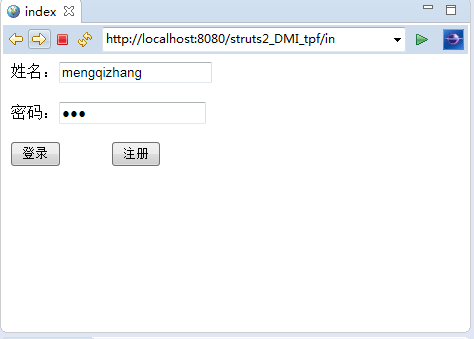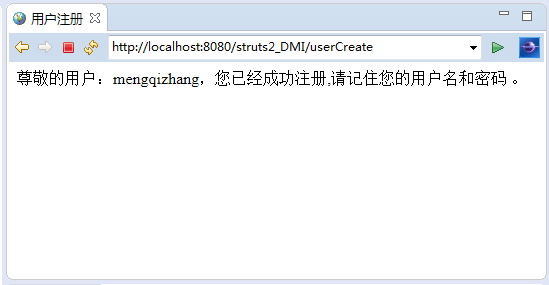一、动态方法调用(DMI:Dynamic Method Invocation)
⒈struts2中同样提供了这个包含多个逻辑业处理的Action,这样就可以在一个Action中进行多个业务逻辑处理。例如:当用户通过不同的提交按钮来提交同一个表单的时候,系统通过不同的方法来处理用户不同的请求,这时候就需要让同一个Action中包含有多个控制处理的逻辑。
⒉动态方法调用有:
①、改变struts.xml中的action中的method属性。
②、改变form表单中的action属性来改变不同提交的请求逻辑。
③、使用通配符。
二、简单示例(改变form表单中的action属性):
①、首先显示一个表单,表单中有两个提交按钮,但分别代表不同的业务。当点击登录时用户登录;当点击注册时用户注册。

②、用户登录:

③、用户注册:

详细代码(本例子建立在struts2的基础上的简单例子,所以struts2的搭建在这里不详细演示,如果对struts2有疑问请求看:http://www.cnblogs.com/demoMeng/p/5841976.html):
①、登录注册的页面(index.jsp):DMI中改变form表单中action属性的方式的就下面的脚本段是关键,其他的struts.xml文件只要进行相关的配置即可。
<%@ page language="java" contentType="text/html; charset=UTF-8" pageEncoding="UTF-8"%> <!DOCTYPE html PUBLIC "-//W3C//DTD HTML 4.01 Transitional//EN" "http://www.w3.org/TR/html4/loose.dtd"> <html> <head> <meta http-equiv="Content-Type" content="text/html; charset=UTF-8">
<script src="js/jquery-1.7.2.js"></script> <title>index</title>
<script type="text/javascript"> $(function(){ $("input:eq(3)").click(function(){ //获取表单并且改变action的属性值 $("#form").attr("action","userCreate"); }); }); </script> </head> <body> <form action="userLogin" method="post" id="form"> 姓名:<input type="text" name="name" /><br><br> 密码:<input type="password" name="password" /><br><br> <input type="submit" value="登录"> <input type="submit" value="注册"> </form> </body> </html>
②、struts.xml:配置文件
<struts>
<package name="myP" extends="struts-default">
<action name="in" class="action.Action" method="go">
<result name="login">WEB-INF/jsp/index.jsp</result>
</action>
<action name="userLogin" class="action.Action" method="test">
<result name="userLogin">WEB-INF/jsp/userLogin.jsp</result>
</action>
<action name="userCreate" class="action.Action" method="create">
<result name="userCreate">WEB-INF/jsp/userCreate.jsp</result>
</action>
</package>
</struts>
③、Action类:
package action; import com.opensymphony.xwork2.ActionSupport; public class Action extends ActionSupport { private String name; private String password; public String getName() { return name; } public void setName(String name) { this.name = name; } public String getPassword() { return password; } public void setPassword(String password) { this.password = password; } public String go(){ System.out.println("去登录注册页面!!"); return "login"; } public String test(){ System.out.println("用户登录"); return "userLogin"; } public String create(){ System.out.println("用户注册"); return "userCreate"; } }
本例子只是简单的DMI中的一种方式,没有加入过多的业务逻辑处理如:用户登录是否正确并且符合条件。只是一个简单示例,具体实战中需要使用到的业务需要进一步修改分析和完善,谢谢浏览。